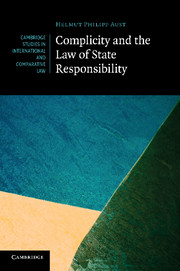Book contents
- Frontmatter
- Contents
- Foreword
- Preface
- Table of cases
- Abbreviations
- 1 Introduction
- 2 Complicity between bilateralism and community interest
- 3 Complicity and the international rule of law
- 4 Complicity in customary international law
- 5 The concept of complicity in Article 16 ASR
- 6 The consequences of complicity
- 7 Complicity and aggravated responsibility
- 8 A network of rules on complicity
- General conclusions
- Bibliography
- Index
8 - A network of rules on complicity
Published online by Cambridge University Press: 07 September 2011
- Frontmatter
- Contents
- Foreword
- Preface
- Table of cases
- Abbreviations
- 1 Introduction
- 2 Complicity between bilateralism and community interest
- 3 Complicity and the international rule of law
- 4 Complicity in customary international law
- 5 The concept of complicity in Article 16 ASR
- 6 The consequences of complicity
- 7 Complicity and aggravated responsibility
- 8 A network of rules on complicity
- General conclusions
- Bibliography
- Index
Summary
We have now surveyed the core aspects of the international law of complicity. At this point, the reader might feel a certain sense of disappointment. Given the structure of Article 16 ASR and the obstacles attached to its implementation, especially before international courts and tribunals, Article 16 ASR may appear as some form of ‘window dressing’, pretending to tackle a pressing issue but offering modest returns in terms of concrete and practical consequences. This feeling is only slightly mollified by the comforting effects of jus cogens which could lead international lawyers to believe that, when the ‘real important’ issues are at stake, international law provides stronger rules on State complicity. This mollification is doubly precarious as the general scope of application of peremptory norms in international law is a fairly modest one, too. Stronger rules on complicity in the system of aggravated responsibility could be only one further component of the aforementioned ‘window dressing’.
However, this assessment could be too negative. International law may provide for further rules which technically deal with different scenarios but have the potential to hold complicit States responsible as well, albeit under a ‘different label’. This chapter will look into some of these possibilities. We will consider both primary and more specialised rules on complicity as well as alternative mechanisms for holding complicit States responsible (section 2). Subsequently, we will discuss their relationship to the general rule that is Article 16 ASR (section 3). In order to contextualise these efforts, we will first summarise weaknesses attached to the general rules on complicity.
- Type
- Chapter
- Information
- Complicity and the Law of State Responsibility , pp. 376 - 418Publisher: Cambridge University PressPrint publication year: 2011

